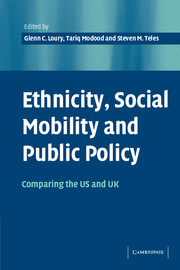Part III - Formal structures
Published online by Cambridge University Press: 22 September 2009
Summary
The papers in the preceding section of this volume look, in broad terms, at the role of race and ethnicity in the production of social mobility, through a focus on families and neighborhoods. The present section focuses more closely on how these forces translate into social mobility outcomes, with additional attention to the critical area of education and ancestry (which we will call “pre-market forces”), and a new emphasis on the way that race and ethnicity are woven into the labor market. The fundamental points of these papers taken as a whole are: (a) important social forces not usually considered in any detail by economists are at work in both arenas; (b) race and ethnicity channel and magnify these forces; and (c) the comparative study of the two countries places these forces in sharper relief.
From the perspective taken here, social mobility is the joint product of the human capital of individuals, combined with the social capital embedded in ethno-racially specific networks. This human and social capital is refracted through the social organization of work, within labor market and political systems that are structured in part by the social meaning of race. Only when all of these considerations are taken together can we have a truly rounded understanding of how groups are stratified and how individuals attain economic and social status.
The standard way of thinking about the influence of racial or ethnic categories in the labor market is the model originally introduced by Gary Becker.
- Type
- Chapter
- Information
- Ethnicity, Social Mobility, and Public PolicyComparing the USA and UK, pp. 255 - 261Publisher: Cambridge University PressPrint publication year: 2005



